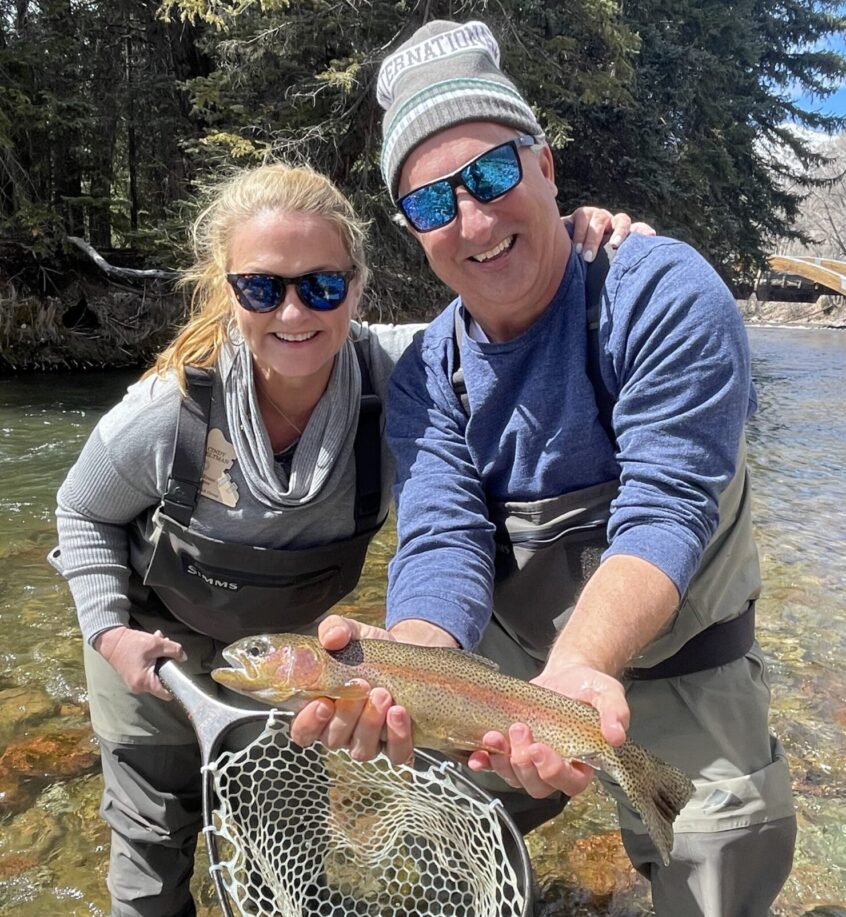Flows and Water Clarity
Water levels on the Roaring Fork are on the rise. Flows are 202 cfs below Maroon Creek (gauge is no longer ice affected… woohoo!) and 526 cfs at Emma. Water clarity has decreased significantly. Visibility is 6 inches to 1 foot.
Overview
Big changes are happening on the river! Flows have doubled in the past week and water clarity has dropped substantially. A few days of really warm weather caused snow to melt and water levels to rise. We’ll have to see what the mix of cooler temperatures and precipitation this weekend and next week will do to water levels and clarity, but it looks like the beginning stages of runoff have started!
Despite the rapid change, the fishing has been lights out! That being said, we’ve had to change tactics to be successful. Decreased visibility means that it’s time to break out some bigger, flashier bugs and put away the tiny midges and baetis. Big stoneflies (Pat’s Rubber Legs, Prince Nymphs, 20 Inchers), worms and larger generalist patterns (Pheasant tails, Hare’s Ears, Jig-style files e.g. Frenchies and Perdigons) have all been catching fish! Midges and BWOs are definitely still present in the system, so trailing upsized (#16-18) midge or baetis patterns with some flash is still a good option if fish are being picky in slower water. That being said, most fish are eating the bigger stuff. Don’t forget that streamers are also on the menu– if you’ve been holding off on chucking meat, now might be a good time to give it a try.
Increased flows have changed how the river looks, so make sure you read the water and see how things have changed in the stretch you’re fishing. Trout are still hanging out in classic pools and runs, but they’ve also started to move into formerly shallower pockets closer to the bank. Rope up on tippet (you probably don’t need that 5x or 6x anymore!) and use more weight to get flies down in faster water.
Variable conditions will make this an interesting week out on the river, so don’t be afraid to switch things up if you’re not finding success.
We continue to be on the lookout for spawning activity, if you see anything please let us know as we want to make sure we’re helping local anglers stay off of redds. Decreased visibility means it can be hard to see where you’re stepping, so try to avoid wading through shallow tail outs as that’s where redds are most likely to be. Read more below.
PSA The Rainbow Trout Spawn
We know that for the most part the fly fishing community is educated and thoughtful about responsible use of the resource and protecting future generations of fish, but we think that it is still worth reminding everyone to be mindful of spawning fish as we move into spring.
Trout create spawning beds or “Redds,” which are generally found in shallow, moving water. Identifying these redds is an important skill as an angler and helps us fish ethically. Redds are generally composed of smaller rocks and gravel that are lighter in color than the rest of the river bottom due to spawning fish brushing the rocks as they mate and clearing them of algae and other organic material. These beds provide safety for the eggs and alveins (fry) that are a result of the spawn and the next generation of fish!
Stay away from redds, fish deeper water where trout are actively feeding, and use good fish handling practices. If you are hitting the water with someone who is new to the sport, please use this time of year as an opportunity to share how to fish ethically and be a steward of the resource. To learn more about fishing during the spring spawn, click here and share!
Common Hatches and Food Sources
Stoneflies, Worms, Caddis and BWOs
Though midges and BWO’s are still present (and will catch fish), we’re switching over to bigger flies like stones, worms and caddis with the increased flows and decreased visibility. Smaller stonefly patterns (size 14-18) that were productive earlier in the spring are still definitely working, but larger bugs (size 8-12) are working now too. If you can fish big, why wouldn’t you! We still aren’t really seeing caddis hatching on the upper fork, but fish are definitely eating them sub-surface.
Hot flies & Techniques
Nymphs
Point Flies
Hot Flies: Pat’s Rubber Legs/Girdle Bug (size black, coffee, brown 6-14), Squirmy or San Juan Worm (Tan, Pink, Blood Worm), 20 incher (size 8-14, natural) Prince Nymph (size 8-16) Guide’s Choice Hare’s ear (size 12-16), Frenchie Style flies (12-16), Perdigon (pearl, size 16).
Tungsten jigs with hot collars (yellow, brown, pink, size 12-16), Eggs (chartreuse, peach, white). Pheasant Tails (black, natural, flashback 12-16).
Midges and Baetis
Hot Flies: Sparklewing RS2 (black, size 16), Chocolate Thunder (black, size 16),
Epoxy Midge (Red, size 16-18), WD40 (black, gray, size 16-18), Miracle Midge (gray, brown, size 16-18) RS2’s (cdc, crystal wing, black, gray, size 18-22), crystal midge (gray, olive, size 20-22), Juju Baetis (red, olive, black size 18-22), Pheasant Tail (natural 18-20).
Dries:
Hot Flies: Griffith’s gnat (classic or hi-vis, 18-22)
Element Hi-Vis Midge (black, size 20) Parachute Adams (18-20), BWO Hackle Stacker (18-20)
Streamers:
Mini Dungeons (black, white, natural (size 8), Mini D&D (purple, olive size 6), Motor Oil (black, size 6), Slumpbuster (natural, size 8-12), Thin Mint (size 6-10).
Techniques
Nymphing is the most productive technique during this time of year. Finding deep holding water and using weight to get your flies down will be crucial to success. Longer leaders and heavy split shot will help you get your flies in front of more fish. Leading with larger jig style or tungsten patterns has been a very productive technique for helping smaller flies get down deeper.
Decreased visibility during runoff provides us the opportunity to fish larger, flashier flies and use heavier tippet. Adjust size, flash and tippet selection depending on the water clarity where you’re fishing. As water levels continue to rise, fish will get pushed into pockets and eddies closer to the bank, but if whitewater isn’t ripping through your favorite holes yet, there are still fish hanging out there,
Dry fly hatches are beginning to increase in frequency, so keep an eye out for pods of rising fish. Spring dry fly hatches can be sporadic compared to the summer months, but are incredibly fun and rewarding to fish. Midges, BWO’s and Caddis are all common spring hatches.
As we move into spring, streamers will become important in your rotation! Small streamers tend to be best during early spring, and be sure to focus your efforts on deep pools and structure.
Information About The Roaring Fork
The Roaring Fork River is a freestone river that runs 70 miles from Independence Pass through Aspen, Basalt, and Carbondale until it reaches its confluence with the Colorado River in Glenwood Springs. The cold, clean waters of this famous river support an incredible array of aquatic life including brown, rainbow and cutthroat trout. The Roaring Fork is designated as a “Gold Medal” fishery, meaning it offers some of the best trout fishing in the nation to beginners and seasoned anglers alike.

